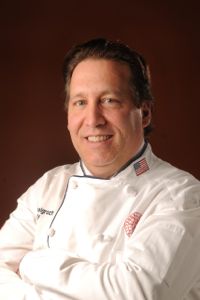Teaching Speed Scratch as Bakery Business Builder
Tuesday, 01 April 2014 03:00
 To baking-and-pastry students with dreams of owning and operating their own bakeshops, whether to create from scratch or utilize a convenience-added product has everything to do with quality and consistency.
To baking-and-pastry students with dreams of owning and operating their own bakeshops, whether to create from scratch or utilize a convenience-added product has everything to do with quality and consistency.
By Mark Kwasigroch
Your mission: Make a batch of turnovers that are light, buttery and flakey. Do you …
One, commit to a multi-step process that includes preparing a base dough with bread flour and all-purpose flour, enclose butter at exactly the right temperature, chill rolled-out dough before rolling out again (then repeat), then cut, fill, fold and bake to consume literally hours for perfect turnovers?
Or two, lay out ready-to-use puff-pastry dough, cut into squares or circles, fill to make sweet or savory, crimp and bake for beautifully golden, fresh-from-the-oven turnovers in minutes?
Today, more American bakeshops (and even bakeshops in France) seek short-cut solutions to creating high-quality classic pastries, breads and other baked goods. This should come as no surprise; after all, the phrase “from scratch” entered the English lexicon as recently as the 1950s—the same decade that produced the first electric can opener. In an industry beleaguered by excruciatingly short profit margins and a dearth of qualified help, “speed scratch,” or the use of convenience products to eliminate time and labor in food preparation, makes a lot of sense.

 If you’re 45 or older, you probably prefer a baked potato over french fries, according to results of a recent study. However you like your potato, it’s the vegetable of choice for nearly one-quarter of Americans, and virtually everyone in this country eats them.
If you’re 45 or older, you probably prefer a baked potato over french fries, according to results of a recent study. However you like your potato, it’s the vegetable of choice for nearly one-quarter of Americans, and virtually everyone in this country eats them. The Los Angeles Dodgers expects to sell more than 3 million hot dogs to fans this season, while the Detroit Tigers unveils the Poutine Dog. Meanwhile, the Chicago Cubs will offer a taste of hot dogs over the last 10 decades at Wrigley Field.
The Los Angeles Dodgers expects to sell more than 3 million hot dogs to fans this season, while the Detroit Tigers unveils the Poutine Dog. Meanwhile, the Chicago Cubs will offer a taste of hot dogs over the last 10 decades at Wrigley Field. Chef Bill Telepan leads school wellness initiatives while running successful restaurants. He says that if you have a chance to give back, do it.
Chef Bill Telepan leads school wellness initiatives while running successful restaurants. He says that if you have a chance to give back, do it. Following up on last month’s inspiration to teach curiosity by capitalizing on the five “W”s, this month Dr. Mayo reveals three additional strategies.
Following up on last month’s inspiration to teach curiosity by capitalizing on the five “W”s, this month Dr. Mayo reveals three additional strategies.